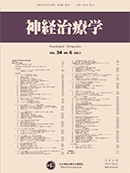35 巻, 3 号
選択された号の論文の66件中51~66を表示しています
シンポジウム4:脊髄小脳変性症の最近の話題
-
2018 年 35 巻 3 号 p. 320-325
発行日: 2018年
公開日: 2018/12/25
PDF形式でダウンロード (981K) -
2018 年 35 巻 3 号 p. 326
発行日: 2018年
公開日: 2018/12/25
PDF形式でダウンロード (164K) -
2018 年 35 巻 3 号 p. 327-331
発行日: 2018年
公開日: 2018/12/25
PDF形式でダウンロード (760K) -
2018 年 35 巻 3 号 p. 332-336
発行日: 2018年
公開日: 2018/12/25
PDF形式でダウンロード (1427K)
シンポジウム5:認知症治療の展望–1
-
2018 年 35 巻 3 号 p. 337-339
発行日: 2018年
公開日: 2018/12/25
PDF形式でダウンロード (398K) -
2018 年 35 巻 3 号 p. 340-343
発行日: 2018年
公開日: 2018/12/25
PDF形式でダウンロード (662K) -
2018 年 35 巻 3 号 p. 344-347
発行日: 2018年
公開日: 2018/12/25
PDF形式でダウンロード (2740K) -
2018 年 35 巻 3 号 p. 348-349
発行日: 2018年
公開日: 2018/12/25
PDF形式でダウンロード (830K)
原著
-
2018 年 35 巻 3 号 p. 350-355
発行日: 2018年
公開日: 2018/12/25
PDF形式でダウンロード (1937K) -
2018 年 35 巻 3 号 p. 356-360
発行日: 2018年
公開日: 2018/12/25
PDF形式でダウンロード (781K) -
2018 年 35 巻 3 号 p. 361-364
発行日: 2018年
公開日: 2018/12/25
PDF形式でダウンロード (1330K)
神経治療最前線 海外学会参加報告
-
2018 年 35 巻 3 号 p. 365
発行日: 2018年
公開日: 2018/12/25
PDF形式でダウンロード (1030K) -
2018 年 35 巻 3 号 p. 366-367
発行日: 2018年
公開日: 2018/12/25
PDF形式でダウンロード (1044K)
-
2018 年 35 巻 3 号 p. 368-371
発行日: 2018年
公開日: 2018/12/25
PDF形式でダウンロード (385K) -
2018 年 35 巻 3 号 p. 373
発行日: 2018年
公開日: 2018/12/25
PDF形式でダウンロード (170K) -
2018 年 35 巻 3 号 p. 374
発行日: 2018年
公開日: 2018/12/25
PDF形式でダウンロード (153K)
